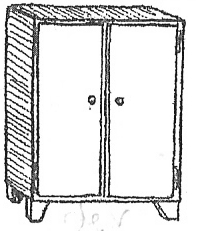

A cupboard is a piece of furniture for enclosing dishware or grocery items that are stored in a home. The term is sometimes also used for any form of cabinet or enclosed bookcase. It gradually evolved from its original meaning: an open-shelved side table for displaying dishware, more specifically plates, cups and saucers. These open cupboards typically had between one and three display tiers, and at the time, a drawer or multiple drawers fitted to them. [1] [2]



